What are the diseases of potato tops: description and treatment
Diseases of potato tops lead to loss of yield and a decrease in starchiness of tubers. The main reason for the development of diseases is pathogenic microorganisms. Preventive measures, the use of healthy planting material, treatment with chemicals and proven folk methods will help to save the harvest.
Read more about why the tops of potatoes turn yellow and dry ahead of time and what to do if the potatoes have wilted, later in the article.
The content of the article
Reasons why potatoes can get sick
Causative agents of diseases - fungi, viruses and bacteria... Noncommunicable diseases are influenced by environmental conditions. With drought and high soil temperatures, early frosts, lack of nutrients in plants, physiological processes are disturbed, which leads to a decrease in productivity and a deterioration in the seed quality of tubers.
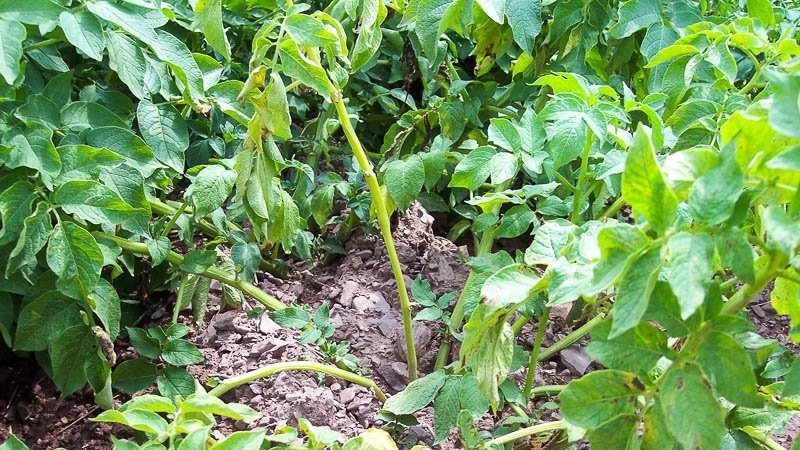
How to distinguish diseases from micronutrient deficiencies and errors in growing and care
With a lack of nutrients and mistakes in care, physiological diseases develop.
The difference between physiological diseases and infectious diseases:
- there is no causative agent of the disease;
- at the same time, most of the plants are massively affected in the garden;
- the course of the disease can be suspended or stopped completely, eliminating the harmful factor of the external environment.
Lack of nutrients simultaneously manifests itself on all organs of the plant and rarely leads to its death... Most often, potatoes are lagging behind in growth. Leaves change color, deform, ovaries die off. An excess of micro- and macroelements causes burns of leaves and death of ovaries.
The table clearly shows the signs of a violation of mineral nutrition:
|
Element |
Symptoms |
|
| Disadvantage |
Excess |
|
| Nitrogen | Light yellow leaf color, growth retardation | Delayed flowering, leaf burns, plant death |
| Calcium | The apical leaves turn pink, curl up into a funnel | Poisoning symptoms unknown |
| Phosphorus | The leaves become smaller, brighten, are located at an angle to the stem. During the period of tuberization, a narrow strip of brown appears at their tips | It rarely manifests itself in the form of chlorosis |
| Boron | Dying off of the growth point, enhanced development of lateral shoots. The internodes are shortened, the bush seems to be squat | In drought, seedlings are delayed, growth is weakened, and chlorosis develops. With sufficient rainfall or timely watering, potatoes recover |
| Potassium | At first, the leaves turn dark green, then bronze, wrinkle and curl down | Potato leaves turn black and shrink |
| Copper | Dying off of leaves in the upper tier | Dark green leaves |
| Manganese | Chlorosis of leaves between veins. With severe starvation, necrotic spots form | Chlorosis at the edges of old leaves |
| Zinc | Necrotic spots on the underside of the leaf blade, chlorosis of the base of the leaf lobes, spreading to their apex | Leaves turn red and die |
Freezing, high humidity or drought leads to wilting and lodging of tops, necrosis and spots on the leaves.
It can be useful:
What are the diseases of potato tops
Infectious diseases - fungal, bacterial and viral, transmitted from diseased plants to healthy.
Fungal
Fungal spores are introduced into plant tissues through stomata or mechanical damage... The mycelium grows, penetrates into cells, feeding on cell sap. The metabolism of plants is disturbed, growth slows down, the yield and keeping quality of tubers decrease.
Late blight
Appears at the beginning of flowering... Rapidly growing brown spots form on the lower leaves. With high humidity, a white bloom forms on the border of healthy and affected areas. In hot weather, the leaves dry up and die off, in rainy weather they rot. The stems are covered with oblong brown spots. Causative agent late blight stored in soil and seeds.
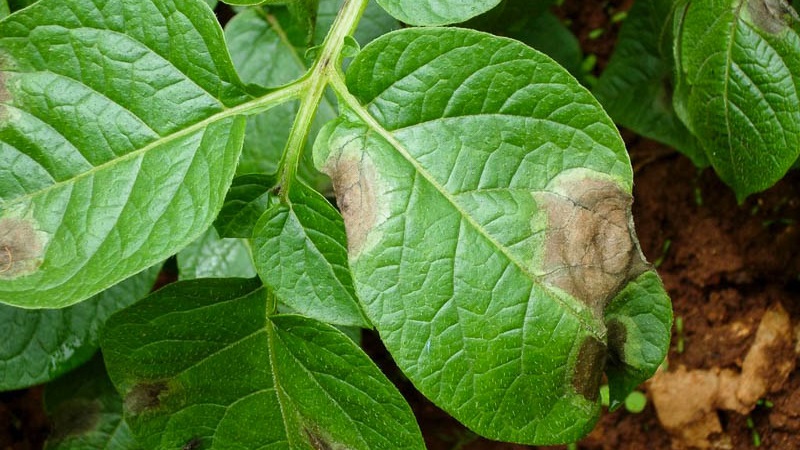
Alternaria
Alternaria potato develops in the budding phase... Brown or black spots with concentric zoning appear on the lower leaves. Then they merge - the tops of the potatoes turn black, the leaves dry out and die off. The development of the disease is facilitated by hot weather with heavy rains and morning dews, a lack of nitrogen.
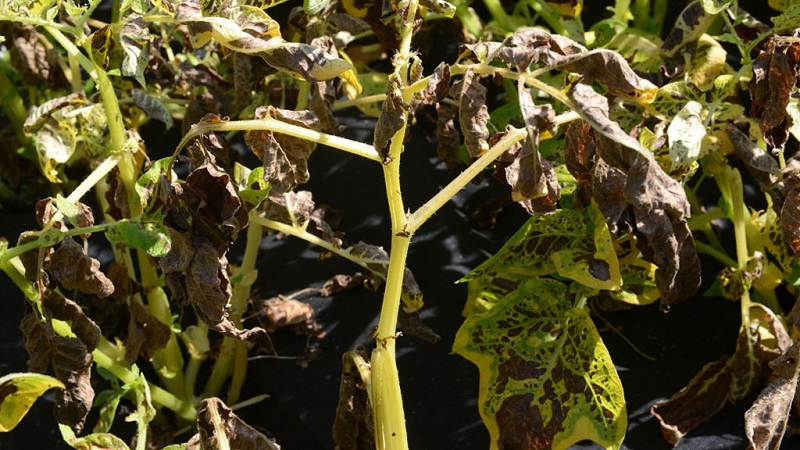
Fusarium wilting
Distributed in the southern and southeastern regions. Causative agent most often affects potatoes during flowering... The upper leaves brighten and wither. The lower part of the stem turns brown, becomes covered with a pink bloom and dies off. Potato tops turn yellow and dry out within a few days.
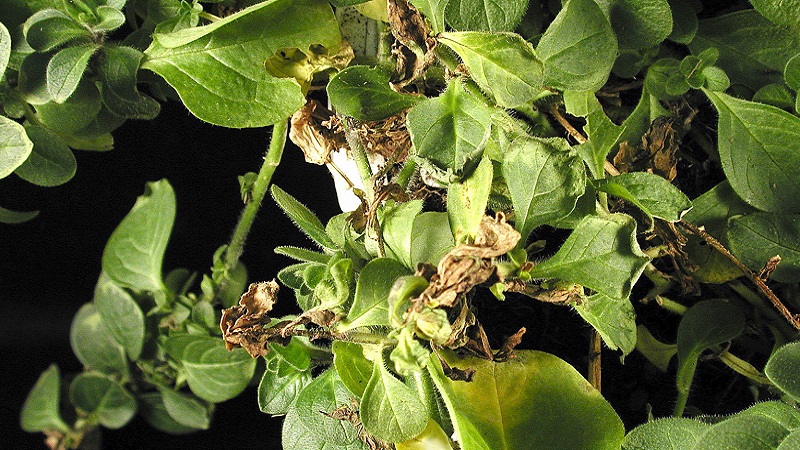
Verticillary wilting
Affects potatoes in the flowering phase... First, the edges of the leaves turn yellow, then light brown spots with a yellow border appear on the plate. In rainy weather, the stems and lower leaves are covered with a thin gray bloom.
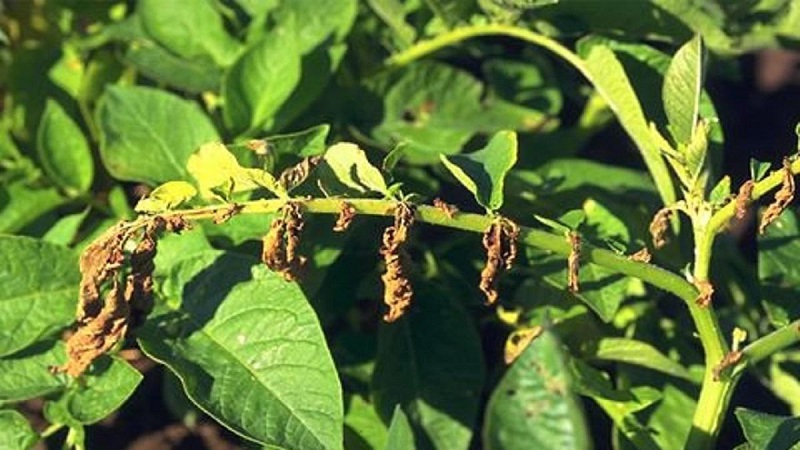
Black scab, or rhizoctonia
Affects stems, causes rot and death of seedlings in areas with cold, prolonged spring... Seedlings grown from sick rhizoctonia tubers become covered with brown spots and die. In the flowering phase, the bases of the surviving stems rot and become covered with a white felt bloom - a "white leg" is formed.
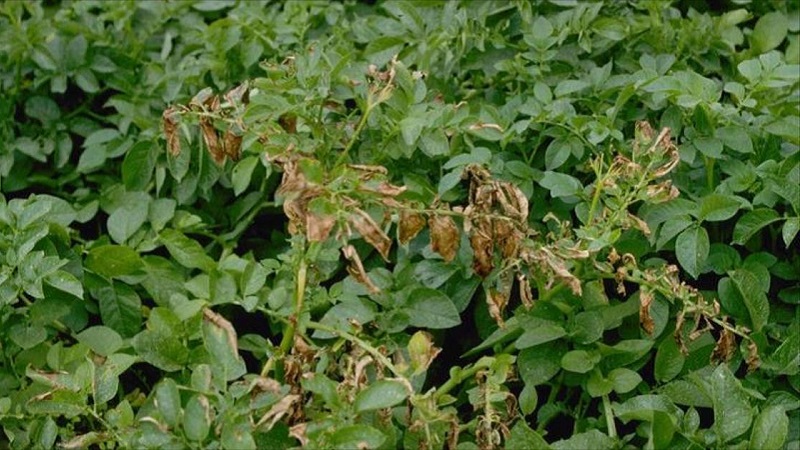
Fomoz
Affects tops in the second half of the growing season... Elongated spots appear on the stems, which brighten over time.
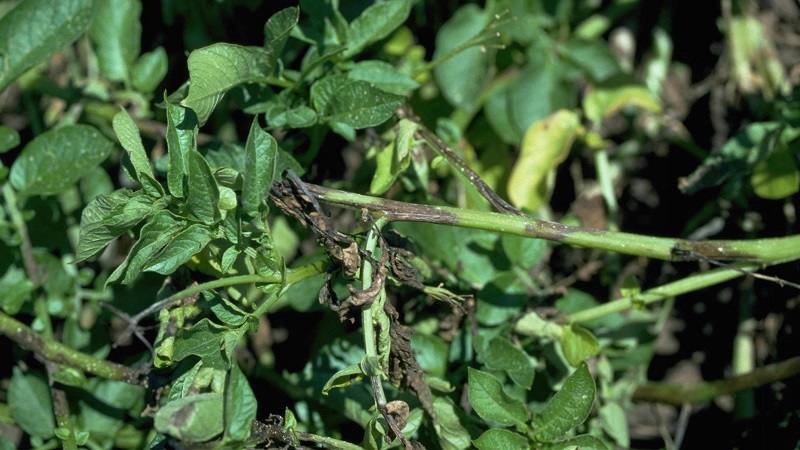
Treatment methods
Use chemical fungicides - "Thanos", "Mancozeb", "Novozir", "Profit". During the growing season, the tops are sprayed with a 0.2–0.3% solution.
Tops treated with biological protective agents 2-3 times with an interval of 7-10 days, starting from the budding phase:
- "Ecosil" - dilute 5 ml in 1 liter of water;
- "Bitoxibacillin" - use 30 g per 1 hundred square meters;
- "Baktofit" - 30-50 ml per hundred square meters;
- Gibbersib - 0.015 g per hundred square meters;
- "Fitosporin" - 6 g per hundred square meters.
Traditional methods:
- before planting, the tubers are treated with copper sulfate - 2 g per 10 l of water or potassium permanganate - 10 g per 10 l of water;
- take 100 g of copper sulfate and soda ash, dilute in 10 liters of water and spray the tops during the growing season - 4-6 liters of working solution will be required for 1 hundred square meters.
An effective method of combating fungal diseases - drying tubers in the sun within 4 hours immediately after digging.
Bacterial
Sources of bacterial infection - soil, weeds from the Solanaceae family, infected tubers.
Ring rot
Ring-rot stalks wither from the top... In humid weather with moderate temperatures, wilting occurs slowly, in hot weather it intensifies.
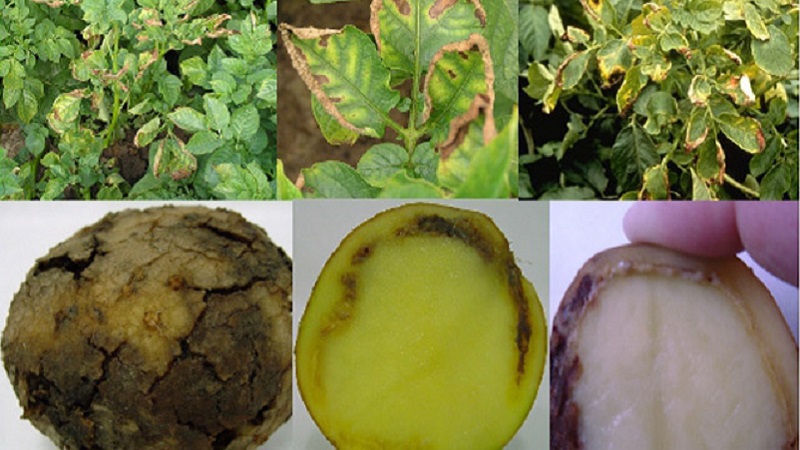
Brown rot
Brown bacterial rot causes the formation of brown oblong stripes on the root part of the stem and on the veins... The first signs appear in the flowering phase - the stems dry up, the leaves wither, shrivel and hang.
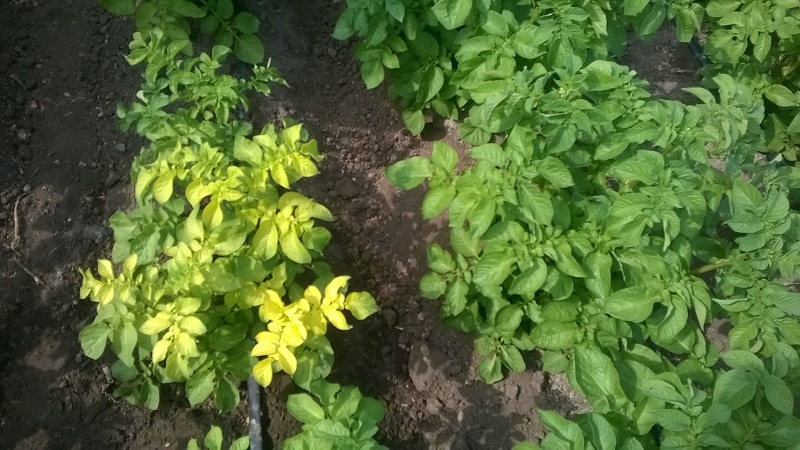
Blackleg
Black leg of potato begins with yellowing of the lower leaves... The upper leaves grow at an acute angle, turn yellow later. The stem rots, softens and easily breaks off in the region of the root collar.
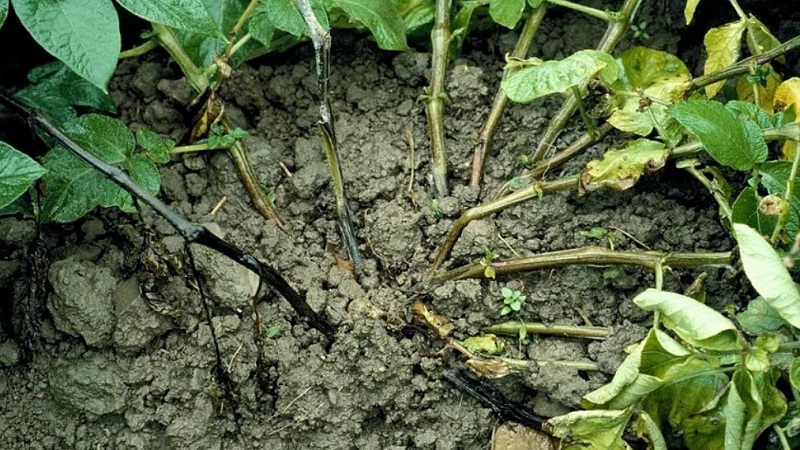
Treatment methods
Diseased plants are removed throughout the growing season... The risk of developing diseases is reduced with timely mowing of tops and harvesting them from the field.
Folk remedies
1 kg of dried wormwood is boiled for 10-15 minutes in a little water... Cool, add 1 liter of infusion from dry poultry droppings (1 kg of droppings insist 1-2 days in a small amount of water). The mixture is filtered and added with water to 10 liters. Add 40 g of laundry soap shavings to the working solution. Potatoes are processed from the beginning of budding 2-3 times with an interval of 2 weeks.
Tops also sprayed with tobacco broth.
Chemical
On the day of planting, the tubers are processed the drug "TMTD" (2.1-2.5 l / t).
Before storage, potatoes are pickled with a fungicide. "Maxim" - for 10 kg of potatoes, take 2 ml of the product, dilute in 50 ml of water and spray.
Biological method: pre-planting treatment with Planriz fungicide - 1 liter of 0.1% working solution is required per 100 kg.
Viral
Sick plants do not respond to treatment... Pathogens accumulate in subsequent generations of tubers.
Important! Viruses are transmitted from diseased plants to healthy contact through insects, fungi, nematodes, cutting tubers, contact of stems, leaves and roots.
Speckled mosaic
Speckled, or ordinary, mosaic leads to a sharp decrease in photosynthesis... On young leaves, light green spots of various shapes and sizes are formed. The tops are stunted, the leaves turn yellow and fall off prematurely.
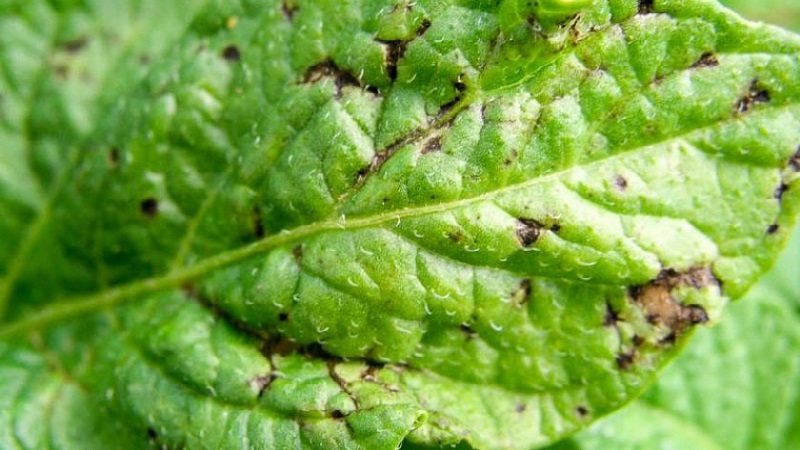
Striped mosaic
Manifests itself as necrotic stripes, mosaics, or leaf spots... Dark brown streaks and spots form on the veins on the underside of the plate. From the lower tier, the lesion spreads to the petioles and stems. By the end of the growing season, the leaves dry out and fall off.
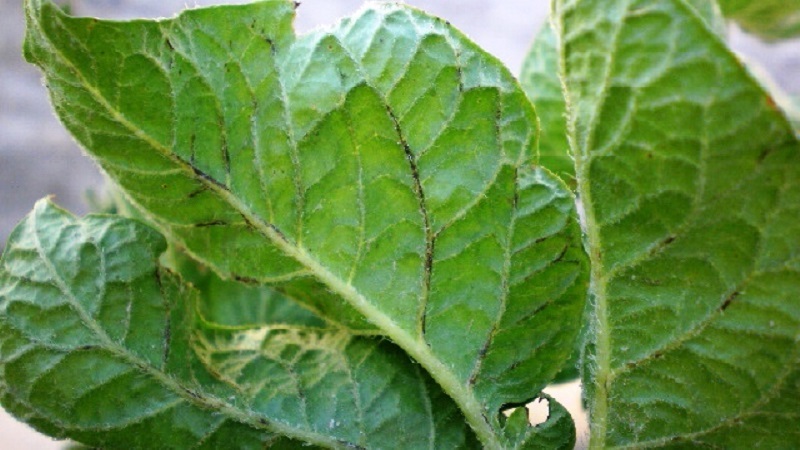
Wrinkled mosaic
Causes up to 30% crop loss... The color of the leaves brightens, the edges of the plates are bent down, corrugation is formed. The leaves die off, hang on the stems without falling off. The disease manifests itself en masse in hot weather in the middle of the growing season. Plants do not bloom, finishing their development 3-4 weeks earlier.
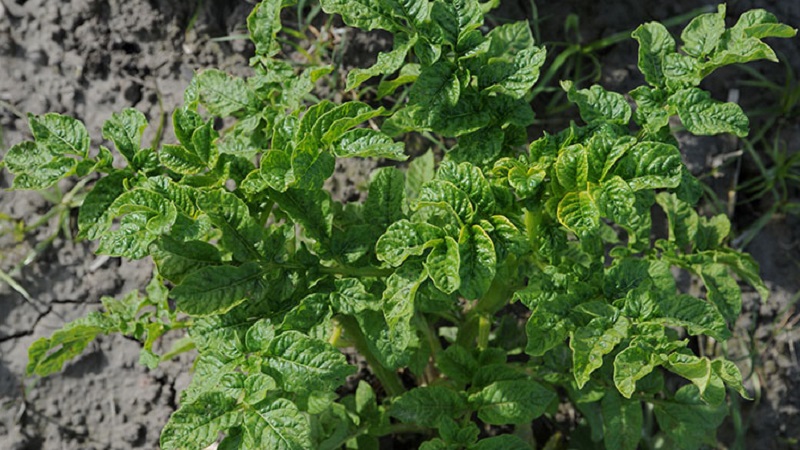
Rolling the leaves
Leads to net necrosis of tubers, reduces yield by 50%... The lower leaf plates curl along the midrib, then become stiff and rustling. Hot weather and lack of moisture contribute to the development of the disease.

Striped veins
Causes bush deformation and growth retardation... Light brown streaks and streaks appear on the leaves. The veins become watery, the leaves die off.
Fighting diseases
Control methods include prophylactic treatment with biologicals "Agat 25 K", "Biosil", "Fitosporin-M", "Gumi-20M". Before planting, the tubers are soaked for 1 hour in the working solution, then dried. Biological products containing a live culture of bacteria and mineral elements develop resistance to viral diseases in potatoes.
Prevention measures
To prevent the development and spread of diseases, crop rotation is observed - the potatoes are returned to their original place earlier than after 3 years. The best predecessors are legumes, grains and melons.
Before storage or before planting, the tubers are heated for 2-3 weeks at a temperature of + 14 ... + 18 ° C. During this time, diseased tubers are identified, only healthy material is used.
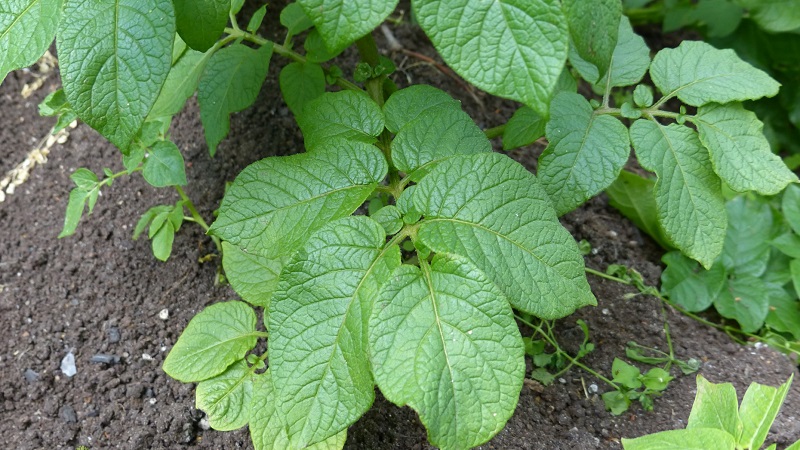
When choosing a variety, take into account that early ripe potatoes are most susceptible to diseases... Virus-resistant varieties are grown - Zekura, Lady Rosetta, Moskvoretsky, Pamir, Luck, Lugovskoy, Maidas.
With the help of insecticidal preparations, they destroy insects, disease vectors - aphids and leafhoppers. After harvesting, all tops and weeds that store infections are burned.
Destroy potato bushes that have grown from overwintered tubers.
Tips and tricks from experienced gardeners
Gardeners share their experience in treating potato tops diseases.
Irina, Yaroslavl: “I examine the potato plant every day. I destroy bushes with ring rot, pour 1 liter of copper sulfate solution into the hole - 100 g per 10 liters of water ".
Maxim, Bryansk: “Before planting, we treat the soil with a solution containing copper against fungal diseases. In the spring, before digging, we dilute 1 tbsp in 10 liters of water. l. copper sulfate or copper oxychloride at the rate of 0.5 liters per 1 m². The second time we spray with Bordeaux liquid 1% at the rate of 0.5 l per 1 m² ".
Anton, Pskov region: “The resistance of tubers to frost and disease is increased if potatoes are fed with potassium sulfate or wood ash during flowering. In 10 liters of water I breed 2 tbsp. l. potassium sulfate or 2 cups of wood ash, pour 0.5 liters under each bush. Potassium sulfate can be replaced with potassium chloride ".
Conclusion
A set of techniques, including preventive and protective measures, will reduce crop losses from diseases of tops and tubers. Studying the causes and symptoms of diseases, timely chemical and biological protection, the use of disinfected tubers during planting - these measures taken in combination will reduce the likelihood of plant damage.